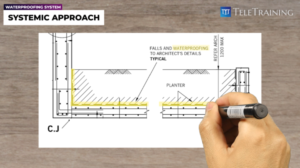Why are waterproofing defects, the most common type of defects in Australian construction?
To answer this question, let’s start by looking at the different parts of the construction process from which waterproofing defects could originate.
The stages of design and installation of a waterproofing system
When it comes to waterproofing system design and installation, there are actually many stages where things could go wrong.
1. Architectural Design
An architect is usually in charge of designing all the features of a structure that relate to waterproofing. This includes designing steps, hobs, fall directions, and drainage types as well as locations. Often, hydraulic engineers are going to add extra information to designs, such as fall amount and drainage size.
2. Membrane Selection
The right waterproofing membrane type needs to be selected for a particular building. This is often done by the architect, although builders can also contribute to this. The membrane manufacturer’s specifications may be incorporated into the design at this stage. In some cases, builders may also specify installation procedures for certain types of membranes.
3. Membrane Application
When a building is ready for waterproofing, an applicator will be engaged to install the waterproofing system. They are often responsible for all related works including substrate preparation, primer & membrane application, and protective coating or boards (if any).
4. Tiling
Often, waterproofing systems are finished with tiling. Not only does the tiler need to leave a nice finish, but they’re also responsible for ensuring that the right falls are built in.
5. Main Contractor Supervision
The main contractor/builder is responsible for overseeing the whole waterproofing process on-site and for ensuring work is done correctly.

So, How do Waterproofing Defects Happen?
Often, the reason that defects happen is because the responsibility is passed from person to person and because people are lacking in knowledge.
A famous drawings note which said “Waterproofing by OTHERS” demonstrates the problem.

As a result, there is a risk that if any party involved in the design or installation of a waterproofing system makes a mistake or fails to spot an issue, the outcome could be a “defect”. There is a risk at every level. It starts with the architects, but all related subcontractors have an important role.
Architects
As qualified and knowledgeable as architects are, waterproofing system designs seem to be something that has been somewhat overlooked. It may surprise you to know that there isn’t even a single university course in waterproofing.
Not only does this lack of attention to training in waterproofing systems put architects at a disadvantage, but it can also cause problems for other people.
So, the architect may make a mistake in the design of a waterproofing system. Alternatively, designs may be scanty, meaning that people further down the line need to plug gaps.
Applicators
The applicator may lack important bits of knowledge. Often, they will assume that the architect will have detailed critical information, such as drying times or sealant compatibilities, in the design. This may not be the case and, if they lack the knowledge to plug this gap, a defect is likely to happen.
Tilers and Other Trades
Tilers and other trades involved in waterproofing systems may not even know that they play a crucial role in the success of a waterproofing system. For example, if a tiler doesn’t install falls correctly, water could move in the wrong direction. This could result in water ingress.
The Main Contractor
The staff that the main contractor employs on-site may lack the knowledge to oversee the installation of waterproofing systems. They may also lack the knowledge to spot omissions or errors made by the applicator or even the architect.

How can we stop defects from happening?
As we said earlier, knowledge of waterproofing systems needs to be improved, across the board.
The most important thing is ensuring that everyone in the chain is fully competent. This applies to architects, subcontractors, tilers, other trades, and last but not least, the builder or main contractor.
Each person’s work is as critical as the next person’s and all it takes to have a water ingress is for one person not to do their job right.
Even a flawless waterproofing design won’t have a chance against water if the fitter can’t follow a design correctly on site. This problem also won’t be spotted if the person supervising their work doesn’t know what to look for.
TeleTraining’s Technical Training Courses Can Help
TeleTraining’s courses, including our introductory waterproofing system design course, have been designed and developed to help fill knowledge gaps in the construction industry.
By providing focused technical training to yourself or your crew, you can make life easier and reduce the risk of expensive and disruptive mistakes.
At TeleTraining, we have worked with a team of subject matter experts, including waterproofing consultants, manufacturers, inspectors and builders, to develop a short yet comprehensive online course for waterproofing systems.
In this 3-hour online course, we start with the basics by looking at what the main membrane types and methods of application are. After that, we look at 7 of the main problems which affect waterproofing systems. For each problem, we look at how and why it occurs and what can be done to avoid it.

This is only the first module from a whole set of modules for waterproofing systems. Stay tuned because we will be publishing more waterproofing system courses next year!




